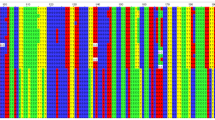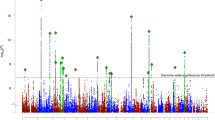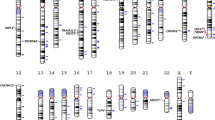Abstract
RECENT work suggests that an autosomal dominant gene for schizophrenia may be located on the 5q11-q13 region of chromosome 5 (refs 1 and 2): a report of schizophrenia associated with trisomy 5q11-q13 in two members of a family of Chinese origin1 prompted the discovery of linkage with markers p105-599Ha and p105-153Ra in five Icelandic and two English schizophrenic families2. The strongest linkage was observed when the phenotype was broadly defined to include minor psychiatric diagnoses not traditionally considered part of the schizophrenia spectrum. By contrast, no evidence was found of linkage in a single multiplex Swedish schizophrenic pedigree3. To determine whether these conflicting results arise from genetic and/or uncertainties in defining the schizophrenic phenotype, we examined fifteen Scottish schizophrenic families with restriction fragment length polymorphisms that span this region. We found no evidence for linkage, regardless of how broadly or narrowly the schizophrenic phenotype is defined, and conclude that a susceptibility locus, whose presence awaits confirmation, on the proximal portion of the long arm of chromosome 5 can be responsible for only a minority of cases of familial schizophrenia.
This is a preview of subscription content, access via your institution
Access options
Subscribe to this journal
Receive 51 print issues and online access
$199.00 per year
only $3.90 per issue
Buy this article
- Purchase on Springer Link
- Instant access to full article PDF
Prices may be subject to local taxes which are calculated during checkout
Similar content being viewed by others
References
Basset, A. S., McGillvray, B. C., Jones, B. D. & Pantzar, J. T. Lancet i, 799–801 (1988).
Sherrington, R. et al. Nature 336, 164–167 (1988).
Kennedy, J. et al. Nature 336, 167–170 (1988).
Spitzer, R. L., Endicott, J. & Robins, E. Research Diagnostic Criteria (RDC) for a Selected Group of Functional Disorders (New York State Psychiatric Institution, Biometrics Research Division, 1978).
Diagnostic and Statistical Manual of Mental Disorders (American Psychiatric Association, Washington DC, 1987).
Endicott, J. & Spitzer, R. L. Arch. gen. Psychiat. 35, 837–844 (1978).
Leppert, M. et al. Science 238, 1411–1413 (1987).
Kendler, K. S., Gruenberg, A. M. & Tsuang, M. T. Am. J. Psychiat. 143, 1098–1105 (1986).
Guze, S. B., Cloninger, R., Martin, R. C. & Clayton, P. J. Arch. gen. Psychiat. 40, 1273–1276 (1983).
Tsuang, M. T., Winokur, G. & Crowe, R. R. Br. J. Psychiat. 137, 497–504 (1980).
Kety, S. S., Rosenthal, D., Wender, P. H. & Schulsinger, F. in The Transmission of Schizophrenia (eds Rosenthal, D. & Kety, S. S.) (Pergamon, Oxford 1968).
Baron, M. et al. Am. J. Psychiat. 142, 447–455 (1985).
Gershon, E. S. et al. Arch. gen Psychiat. 45, 328–336 (1988).
Lathrop, G. L. & Lalouel, J. M. Am. J. hum. Genet. 36, 460–465 (1984).
Author information
Authors and Affiliations
Rights and permissions
About this article
Cite this article
Clair, D., Blackwood, D., Muir, W. et al. No linkage of chromosome 5q11-q13 markers to schizophrenia in Scottish families. Nature 339, 305–309 (1989). https://doi.org/10.1038/339305a0
Received:
Accepted:
Issue Date:
DOI: https://doi.org/10.1038/339305a0
This article is cited by
-
A joint history of the nature of genetic variation and the nature of schizophrenia
Molecular Psychiatry (2015)
-
Disrupted-in-Schizophrenia-1
Current Psychiatry Reports (2008)
-
Molecular genetics of psychopathologies: A search for simple answers to complex problems
Behavior Genetics (1996)
Comments
By submitting a comment you agree to abide by our Terms and Community Guidelines. If you find something abusive or that does not comply with our terms or guidelines please flag it as inappropriate.



